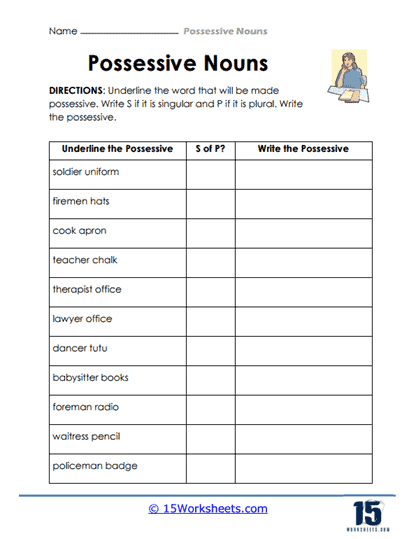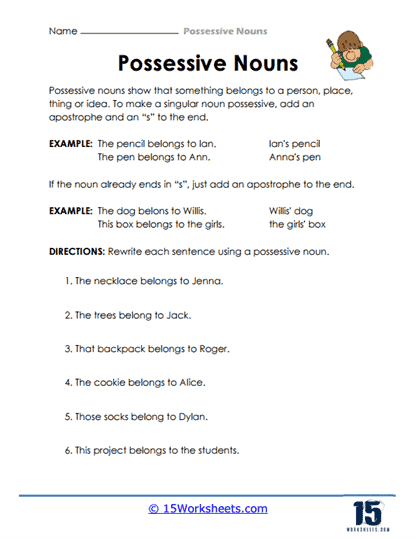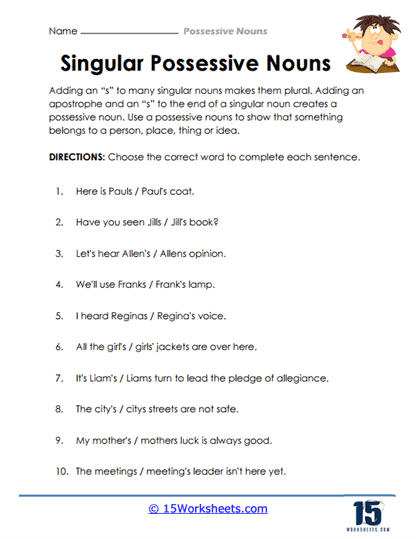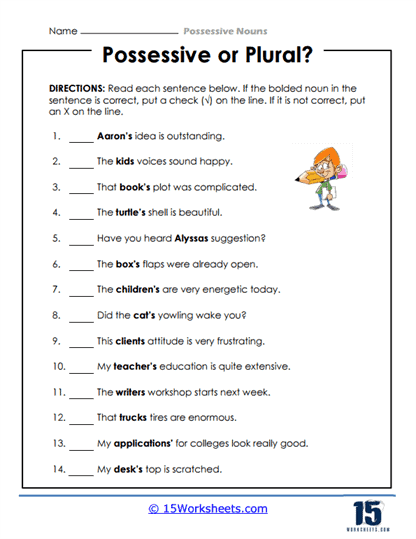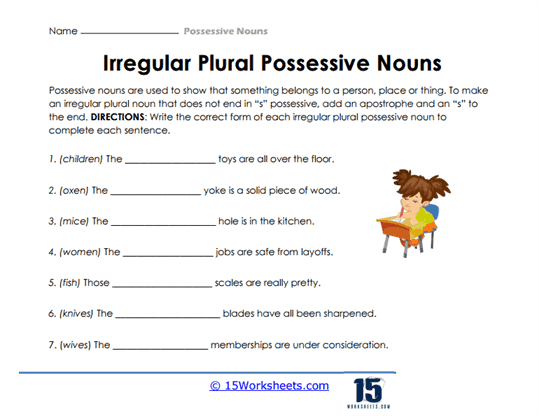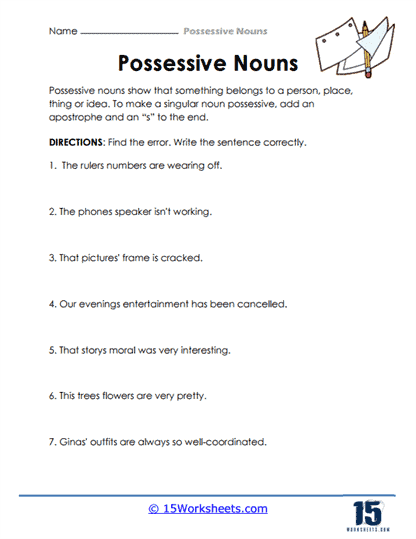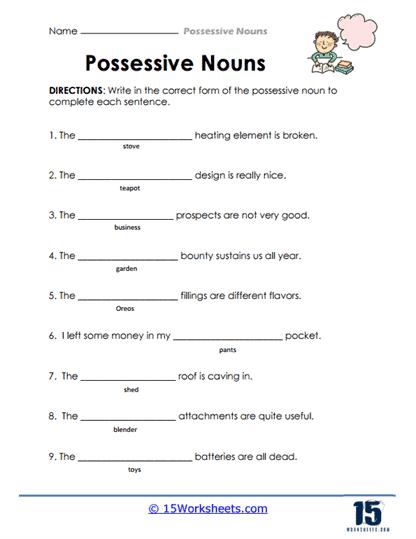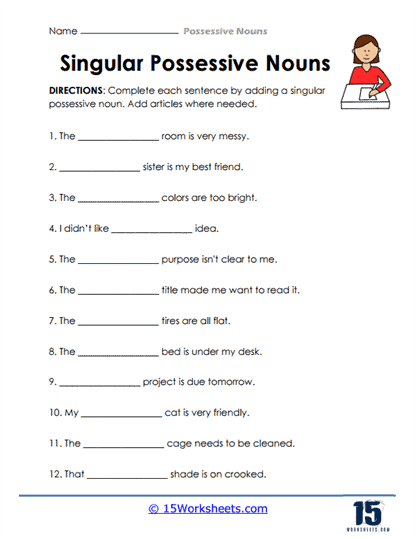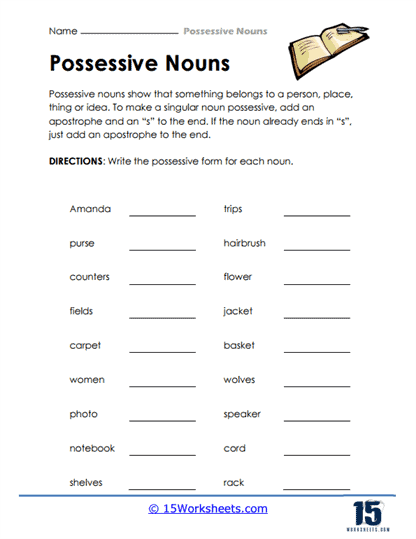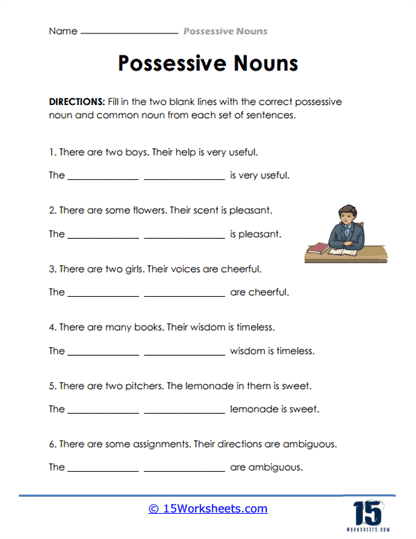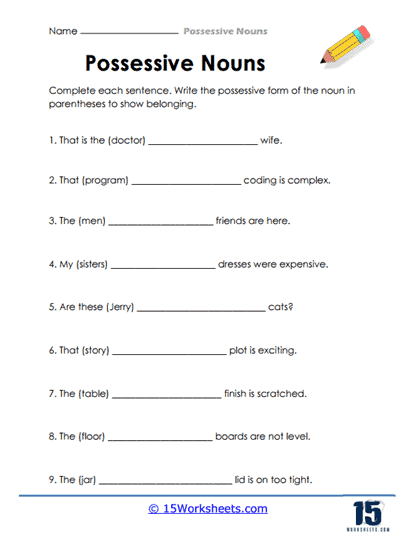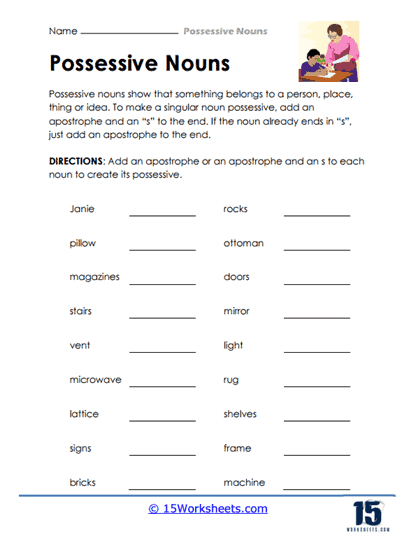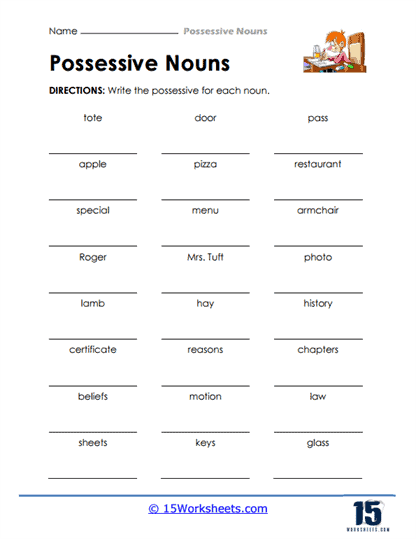Possessive Nouns Worksheets
All About These 15 Worksheets
Possessive nouns often present a unique challenge in English grammar, particularly for learners who may already be grappling with the complexities of sentence structure, verb tenses, and punctuation. For educators, the task of teaching possessive nouns can feel daunting, as it requires students to recognize and apply rules that are often less intuitive than other grammatical concepts. That is why it is essential to find effective methods for conveying the rules surrounding possessive nouns in a way that students can easily understand and apply in their writing. Possessive nouns, which show ownership or relationships between objects and people, are a critical component of clear communication. If students fail to grasp this concept, it can lead to confusing sentences and miscommunication in their writing. Therefore, teaching this aspect of grammar in a way that resonates with learners is of paramount importance.
These worksheets offer much more than a list of exercises; they serve as comprehensive educational resources that break down the rules of possessive nouns into manageable steps. By providing structured examples and exercises, these worksheets guide students through the often-confusing rules for forming possessive nouns, whether it be adding an apostrophe before or after an “s” depending on whether the noun is singular or plural. This systematic approach helps demystify the concept for learners, enabling them to practice and apply the rules in a variety of contexts. The repetitive nature of worksheet exercises allows for reinforcement, which is crucial for long-term retention. When students are given the opportunity to see these grammar rules in action, they are better equipped to use possessive nouns correctly in their own writing.
This collection of worksheets serve students at different levels of proficiency. Whether students are being introduced to possessive nouns for the first time or are revisiting the concept to refine their skills, these educational tools offer versatility and adaptability. For beginners, worksheets often start with simple exercises, focusing on basic possessive forms, such as “the cat’s toy” or “John’s book.” As students progress, more complex sentences are introduced, requiring learners to deal with plural possessives or irregular nouns, thus deepening their understanding. Worksheets can also be customized or scaled in difficulty to match the needs of individual learners or classroom groups. This ensures that every student, regardless of their starting point, can benefit from the structured practice that these resources provide.
Perhaps one of the most significant benefits of using possessive noun worksheets is the clarity and confidence they instill in students. By breaking down the grammar rules into smaller, digestible parts, these worksheets help students overcome the initial confusion that often accompanies learning about possessive forms. The step-by-step guidance not only teaches students the rules but also shows them how to apply those rules in different writing scenarios, from simple sentences to more complex narrative structures. Over time, as students practice and become more familiar with possessive nouns, they are likely to make fewer mistakes and develop a stronger command of the language. This not only improves their writing but also boosts their overall confidence in using English, both in academic settings and in everyday communication.
Structured Exercises
One of the primary features of these worksheets is the variety of exercises they offer. Students are not just expected to read about possessive nouns; they actively engage with the material through exercises that include fill-in-the-blank activities, sentence corrections, and identification questions. For example, students might be asked to complete sentences by inserting the correct possessive form of a noun, such as changing “the book of Sarah” to “Sarah’s book.” This not only tests their understanding of the rule but also provides a hands-on application of possessive forms in real-world contexts. By encountering possessive nouns in different sentence structures, students gradually build confidence in recognizing and using them accurately.
Consider the common confusion students often experience between plural and possessive forms. For example, students may write “the dogs bone” instead of the correct possessive form, “the dog’s bone.” Worksheets that focus on this distinction help learners see the critical difference between simply making a noun plural and showing ownership. The more students practice distinguishing between sentences like “the cars are parked outside” and “the car’s engine is broken,” the more they develop a keen awareness of how possessive nouns function to convey ownership in writing.
Practical Applications
In addition to identification exercises, possessive noun worksheets often challenge students to rewrite sentences, providing opportunities to transform regular phrases into possessive constructions. For instance, a sentence like “the hat that belongs to my brother” would need to be rewritten as “my brother’s hat.” This exercise not only reinforces the rule but encourages students to think critically about the structure and meaning of sentences. Rewriting tasks also help students become more versatile in their writing, allowing them to experiment with different ways to express possession, a skill that is particularly useful when writing essays or creative stories.
Another important aspect of these worksheets is the inclusion of exercises that involve spotting and correcting errors. By reviewing sentences with mistakes in possessive usage, such as “the childrens’ toys” instead of the correct form “the children’s toys,” students sharpen their editing skills. This ability to self-correct is crucial as students progress to higher levels of writing, where accuracy becomes increasingly important. These error-correction tasks are not only helpful for mastering grammar rules but also for developing a more careful and attentive approach to writing in general.
Broad Coverage of Possessive Noun Forms
One of the reasons these worksheets are so effective is that they cover a comprehensive range of possessive noun forms. They move beyond the basic rules of singular possessive nouns, such as “John’s hat” or “the teacher’s desk,” and delve into more complex territory, including plural possessives and possessive pronouns. Students are often challenged by possessive constructions like “the dogs’ leashes” or “the children’s playground,” where the rules change slightly based on the number of owners involved. Worksheets that include these more advanced examples provide students with a well-rounded understanding of possessive nouns, ensuring they are prepared for any grammatical challenge they may encounter.
Possessive pronouns are another important feature of these exercises. Words like “hers,” “theirs,” and “ours” function similarly to possessive nouns but often confuse students because they don’t follow the same rules as adding an apostrophe and ‘s’. Through targeted exercises that incorporate possessive pronouns, students can develop a more nuanced understanding of how possession is conveyed in English, further refining their grammar skills and usage.
Building Long-Term Grammar Skills and Writing Accuracy
The ultimate goal of using possessive noun worksheets is not simply to get students through a few lessons but to equip them with lasting grammar skills. As students work through these exercises, they are internalizing the rules that will improve the accuracy of their writing over time. Possessive nouns are a fundamental part of grammar, and mastering their correct use can significantly enhance a student’s overall writing clarity and precision. By regularly practicing with these worksheets, students develop the kind of grammar knowledge that makes their writing more polished and professional.
For example, imagine a student working on a story about their family’s vacation. Without a solid grasp of possessive nouns, they might write sentences like, “My parents car broke down,” which sounds awkward and unclear. After practicing with possessive noun worksheets, that same student could confidently write, “My parents’ car broke down,” making their writing much clearer and easier to understand. The worksheets help them to internalize these rules so that they can apply them effortlessly, both in the classroom and in real-world writing scenarios.
Confidence Building
One of the most valuable aspects of possessive noun worksheets is their ability to reinforce lessons that have been taught in the classroom. Teachers often introduce grammar concepts through lectures or discussions, but it is through practical application that students truly begin to grasp these ideas. Worksheets serve as a bridge between learning and application, giving students the opportunity to practice and reinforce what they have learned. This repetition is key to long-term retention, as it helps solidify the rules of possessive nouns in students’ minds.
As students become more comfortable with possessive nouns through consistent practice, they begin to build confidence in their language abilities. For many students, grammar can feel like a daunting subject full of rules and exceptions. However, by completing structured worksheets and seeing their own progress, students start to feel more in control of their learning. This boost in confidence can lead to greater participation in class, more willingness to take on challenging writing tasks, and a stronger overall performance in language arts.
Possessive nouns and their rules
Possessive nouns are a type of noun that show ownership or possession of something. In English grammar, there are several rules for forming possessive nouns.
- Singular possessive nouns are used to show ownership of a singular noun. To form the singular possessive of a noun, add an apostrophe and an “s” (‘s) to the end of the noun. For example:
- The cat’s tail
- Mary’s car
- The teacher’s book
- Plural possessive nouns are used to show ownership of plural nouns. To form the plural possessive of a noun that ends in “-s,” add only an apostrophe. To form the plural possessive of a noun that does not end in “-s,” add an apostrophe and an “s” (‘s). For example:
- The cats’ tails
- The children’s toys
- The women’s hats
- Some nouns have irregular possessive forms that do not follow the typical rules of adding an apostrophe and an “s” (‘s) to the end of the noun. For example:
- The man’s shoes —> The shoes of the man
- The tooth fairy’s wand —> The wand of the tooth fairy
It’s important to use possessive nouns correctly in a sentence to ensure that the meaning is clear. For example, “The cat’s food bowl” means that the bowl belongs to one cat, while “The cats’ food bowl” means that the bowl belongs to multiple cats.
In summary, possessive nouns show ownership or possession of something. Singular possessive nouns add an apostrophe and an “s” (‘s) to the end of the noun, while plural possessive nouns add an apostrophe and an “s” (‘s) or only an apostrophe, depending on the noun. Some nouns have irregular possessive forms that must be learned individually.

